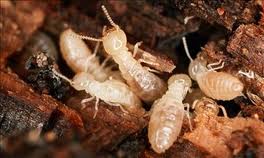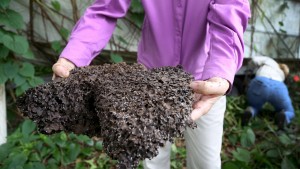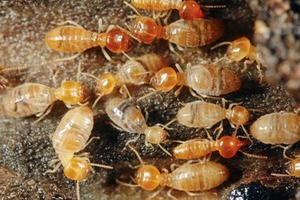 Nasutitermes Corniger, more commonly referred to as the conehead termite, is an invasive species of termite that aggressively eats wood in just about any form. Its nickname stems from the cone shape of its soldier termites’ heads. Soldiers make up an unusually large portion of the total conehead termite colony – anywhere from 20-30% of the colony. Only 1-2 percent of subterranean and drywood colonies are soldiers. Another way to distinguish conehead termites is by the appearance of their tunnels. While subterranean termites also build mud tunnels, coneheads build wider and much more extensive tunnels than subterranean. Still another distinctive characteristic is the appearance of their nest. Visible conehead termite nests are usually built in the open, perhaps in a tree, and look like a large, dark-brown “bumpy” round or oval shaped ball.
Nasutitermes Corniger, more commonly referred to as the conehead termite, is an invasive species of termite that aggressively eats wood in just about any form. Its nickname stems from the cone shape of its soldier termites’ heads. Soldiers make up an unusually large portion of the total conehead termite colony – anywhere from 20-30% of the colony. Only 1-2 percent of subterranean and drywood colonies are soldiers. Another way to distinguish conehead termites is by the appearance of their tunnels. While subterranean termites also build mud tunnels, coneheads build wider and much more extensive tunnels than subterranean. Still another distinctive characteristic is the appearance of their nest. Visible conehead termite nests are usually built in the open, perhaps in a tree, and look like a large, dark-brown “bumpy” round or oval shaped ball.
Conehead termites are species native to the Caribbean. They were first brought to Florida via wooden Pallets delivered from Caribbean Island in 2001. Residents in Florida referred to them as ‘Tree Termites’ for years but they were renamed conehead termites to alleviate the misconception that this pest is only found in trees. They act like peers infesting any wood it can find to feed, build colonies, and generally wreak havoc.
They grow in hot, humid environment, which is why they prefer tropical and sub tropical region. Unlike most termites, the conehead termite does not rely on underground tunneling to travel. Instead, they forage on the ground like ants, allowing them t o spread quickly. Conehead termites are an extremely aggressive termite species known for causing widespread property damage in a short period of time.
 Termites are nothing new to South Florida; 20 or so species provide a challenge to homeowners and a steady income to the pest-control industry. What makes this termite different is that it lives above ground, so it doesn’t compete with the more common subterranean termites.“The behavior and biology of conehead termites are entirely different from what the industry is accustomed to,” said Allen Fugler, executive vice president of the Florida Pest Management Association. “It will build a nest in a tree. It looks like a paper wasp nest, and it could be easily overlooked, even by trained professionals.”
Termites are nothing new to South Florida; 20 or so species provide a challenge to homeowners and a steady income to the pest-control industry. What makes this termite different is that it lives above ground, so it doesn’t compete with the more common subterranean termites.“The behavior and biology of conehead termites are entirely different from what the industry is accustomed to,” said Allen Fugler, executive vice president of the Florida Pest Management Association. “It will build a nest in a tree. It looks like a paper wasp nest, and it could be easily overlooked, even by trained professionals.”
In early 2000, The department of agriculture along with Florida Pest Management Association and Certified Pest Control Operators of Florida worked together to devise consistent, reliable control methods the average pest-control operator can use. The department had requested $202,000 from the state Legislature and the National Pest Management Association lobbying Congress for matching funds on a three to one ratio, for a maximum of $606,000 in federal money. The funds were used towards training and subsidizing termite control for property owners, who can’t afford it, said Missy Henriksen, vice president of public affairs for the National Pest Management Association.
Let us have a look at the below article regarding how this coneheads again invaded the colonies in south Florida’s Dania Beach.
Conehead termites invade Dania Beach
Species first discovered in city in 2001
Author: Jenise Fernandez, Reporter, jfernandez@local10.com
Published On: Apr 28 2015 12:49:50 PM EDT Updated On: Apr 28 2015 12:57:00 PM ED
DANIA BEACH, Fla. –
 Broward County is experiencing a major bug problem, as conehead termites are spreading throughout the area just before termite swarming season.
Broward County is experiencing a major bug problem, as conehead termites are spreading throughout the area just before termite swarming season.
The conehead termites popped up in Dania Beach about 14 years ago. Since then, experts have been able to contain the species. On Tuesday they were out at several properties, destroying nests before swarming season.
Experts said the colonies of conehead termites are nestled in the trees and not visible to the naked eye.
The insect is a ravenous Caribbean termite that’s easily recognizable by its pointy head. The species is also considered dangerous and highly adaptable.
 “It can also get into ornamentals, fruit trees. There’s almost nothing that it won’t eat,” science adviser Barbara Thorne said.
“It can also get into ornamentals, fruit trees. There’s almost nothing that it won’t eat,” science adviser Barbara Thorne said.
The species first popped up in Dania Beach in 2001.
To prevent them for spreading, experts go out once a year to try to destroy the nests in hopes of eradicating the species altogether.
“What you want to do is contain them here and kill them before they swarm to another location,” Andy Rackley, with the Florida Department of Agriculture, said.
A property off of Southwest 45th Street is one of two active nesting grounds for the conehead termites. But despite that, experts believe they’re doing a good job at making sure the species doesn’t spread throughout the county.
Experts said once they spot a nest, they destroy and incinerate it. Meanwhile, tens of thousands of termites are expected to take to the air and find their territories during swarming season.
“This termite is very capable of spreading quickly and probably quite far in South Florida if not beyond,” Thorne said.
The process of killing the termites takes about a day and a half. Once the nests are destroyed, experts will come back out to make sure no more pop up.
These pointy heads are responsible for much of the estimated $40 billion in economic losses attributed to termites annually. Their habitat ranges over in South Florida, already home to a daunting number of invasive plant and animal species thriving where they should not. It is not always possible for an untrained individual to see evidence of termites; however, homeowners can sometimes identify a potential termite problem by being vigilant in and around the home. Thus termination of these termites is need of an hour.
C Tech Corporation can offer a solution to overcome this problem. Our product Combirepel™ is an extremely low toxicity and extremely low hazard and eco-friendly rodent aversive. Combirepel™ is available in the form of solid masterbatches, liquid concentrate and in lacquer form. The product is compliant with RoHS, RoHS2, and REACH and is FIFRA exempted. This product acts through a series of highly developed intricate mechanism ensuring that rodents are kept away from the target application.
The fencing and tree guards can be coated withCombirepel™ to protect the trees, shrubs etc. from the damage caused by the grey squirrels. The product can also be incorporated into agricultural films, greenhouse films, plastic mulches used on a large scale in the agriculture as well as horticulture sector in order to avoid damages caused by these squirrels to fruits and vegetables. Also, the products can be directly incorporated in the polymer matrix during processing of pipes and tubing. Combirepel™ does not leach out, thus there is no soil pollution. Groundwater reserves are also not polluted. Also the non-target beneficial species like earthworms, bees etc are not affected.
The product is compliant with ROHS, ROHS2, ISO, REACH, APVMA, NEA, EU-BPR, and FIFRA exempted.
Contact us at technical.marketing@ctechcorporation.com if you’re facing problems with rodents and get best remedies to combat the pest menace.
Also, visit our websites:
http://www.ctechcorporation.com/
http://www.rodrepel.com/
http://www.termirepel.com/
http://www.combirepel.com/
Follow our Facebook pages at:
1] https://www.facebook.com/Combirepel-411710912249274/
2] https://www.facebook.com/Termirepel-104225413091251/
3] https://www.facebook.com/Rodrepel-120734974768048/
Follow us on our Twitter pages at:
1] https://twitter.com/rodrepel
2] https://twitter.com/termirepel
3] https://twitter.com/combirepel

